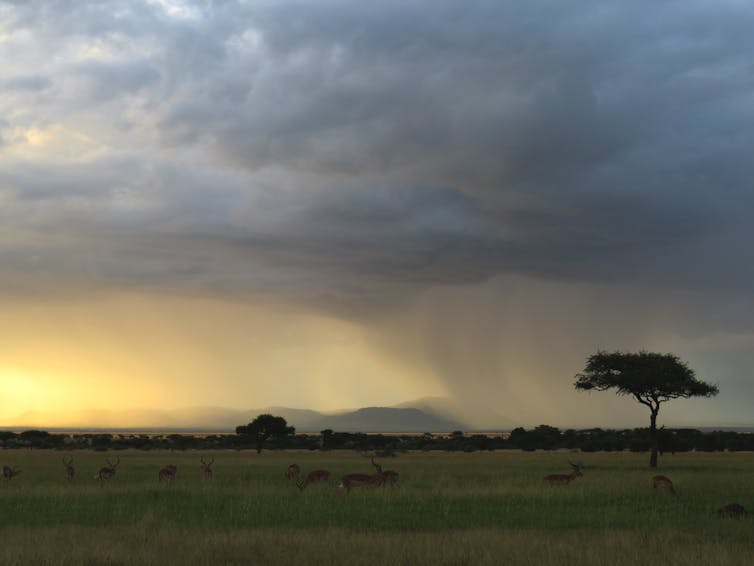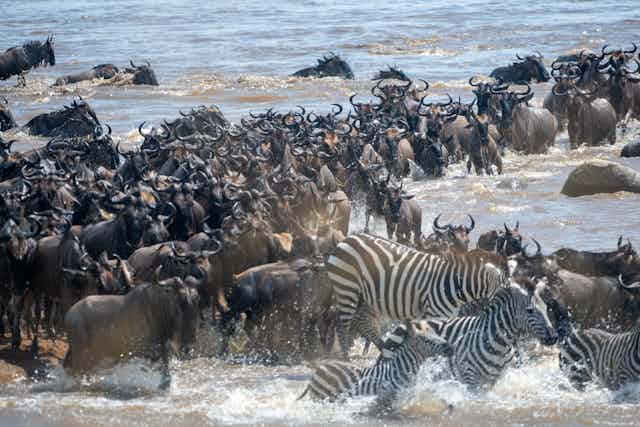Tanzania’s Serengeti ecosystem is like a time machine. As one of the world’s last remaining fully intact grazing ecosystems it provides a glimpse of what others in Australia, Eurasia and the Americas might have looked like when communities of large grazing mammals roamed freely across these continents.
During the Late Pleistocene, which spanned from 129,000 to 11,700 years ago and is sometimes referred to as the “ice age”, populations of these grazing animals collapsed all over the world.
But those populations left a mark: the effect they had on plant communities. Animals and plants shape each other’s evolution. These effects are visible and continuing in the Serengeti. One way this plays out is during one of Earth’s last great herbivore migrations – of zebras, wildebeest and Thomson’s gazelles in Serengeti National Park in northern Tanzania.
Since the early 1970s there have been various theories about what explains the order and timing of the three main Serengeti migratory herbivores. Is it always zebras first, followed by wildebeest and then gazelles? Is that because of competition for the best food? The foraging benefits that smaller herbivores gain from following larger herbivores? Or the risk of being eaten by predators?
Now we believe we have the answer. In our new research in the journal Science, we report that the large herds sweeping across the grasslands of Tanzania in synchronised migration waves overlap in patterns that can be influenced by fire and rain.
Our findings may help conservationists manage migratory herbivore populations, especially as they face future threats due to human induced climate change.
Various hypotheses
The Serengeti is composed of the Serengeti National Park, the Maasai Mara in Kenya, and several smaller protected areas. It’s a tropical savanna dominated by grass. Thorny acacia trees are sparsely scattered in the grassland.
Several competing hypotheses have emerged in the past five decades about the Serengeti migration.
In 1971, Richard Bell, a leading researcher in African savanna ecology and conservation, described the Serengeti migration as a “grazing succession”. During this year-long trek, African herbivores navigate an ecosystem the size of Lesotho (about 30,355km²) in a way that depends on body size.
In his description zebras come first. Wildebeest follow about eight weeks later. And, again about eight weeks later, Thomson’s gazelles follow. The description painted the migration as a giant game of follow the leader, smaller herbivores benefiting from following larger herbivores. Zebras (and then wildebeest) graze the tallest, low-quality components of grass. This exposes the more nutritious grass tissues nearer to the ground and promotes the regrowth of fresh, high-quality leaf tissue.
By visiting a grassland patch weeks after being grazed by larger herbivores, the smaller herbivores, which require more protein per unit body weight, can be selective and obtain better nutrition per bite.
In the years after Bell’s seminal paper, other competing hypotheses emerged which could also account for the movement patterns of Serengeti migratory herbivores.

Some authors argued that competition between grazing species explained the body-size dependent order of migration. Anthony Sinclair of the University of British Columbia, for instance, argued that wildebeest, because of their enormous population size and capacity to reduce the height of vegetation, out-compete zebra for food. This forces zebras to seek taller vegetation to meet their energy demands. Under the competition hypothesis, zebras migrate in front of the wildebeest because they are consistently nudged forward so that they encounter abundant forage, lest they be left behind to starve behind massive herds of wildebeest.
Finally, the mixed herding behaviour sometimes observed during migration was proposed as an anti-predation strategy which reduced the risk of being killed by large predators such as lions, cheetahs and leopards. This hypothesis argues that, if herbivores must move to obtain forage, they should do so in groups that contain other species to decrease their chance of being killed by predators.
Breakthrough
The size of the migration (around two million animals), involving large herbivore populations and a huge spatial footprint, made it nearly impossible to explicitly test these hypotheses.
Then, in 2010, Craig Packer from the University of Minnesota launched a bold project to establish 200 camera traps in central Serengeti. Today the Serengeti camera trap database offers the longest running camera trap study in Africa. It is one of the most significant spatiotemporal databases of herbivore occupancy, movements and habitat selection ever collected.
Meanwhile, Grant Hopcraft of the University of Glasgow was attaching GPS satellite collars to migrating wildebeest and zebras to track animal movements.
Other satellites, operated by Nasa, provide data on vegetation growth and fires, which animals respond to on a year-to-year basis.
Finally, Rob Pringle’s lab at Princeton pioneered an emerging technology that relies on DNA sequence data from the faecal matter of individual herbivores. This opened the door to quantifying herbivores’ diets over time and space.
A combination of camera trap observations and multiple seasons of dietary and GPS collar data allowed me and my collaborators to, for the first time, explicitly test the mechanisms proposed to control the Serengeti migration.
Our study
We made several major findings.
First, the movement of migratory herbivores only cursorily matched the classic predictions of grazing succession. Rather than spacing themselves months apart as observed by Bell, zebras and wildebeest travelled closer together than expected. They also frequently crossed paths during migration. Thomson’s gazelles followed behind the larger migrants by approximately three weeks. This was consistent with the classic predictions of grazing succession and foraging facilitation, but over a shorter window than reported by Bell.
Second, statistical analyses developed by Wake Forest University professor Staci Hepler revealed spatial associations between Thomson’s gazelles and wildebeest that were strong in high rainfall years and weakened in years with widespread fires. This strengthened the evidence for foraging facilitation on the tail end of the migration.
The movements of individual collared zebras and wildebeest demonstrated a striking pattern: zebras consistently selected habitats away from wildebeest, and more so in a dry year. Wildebeest, though, were indifferent to the location of zebras during habitat selection. Dietary analysis revealed strong grass consumption and considerable overlap between zebras and wildebeest. And Thomson’s gazelles consumed largely flowering plants that would have only become accessible after larger herbivores removed the tall grasses.

Together the results suggested a “push-pull” mechanism of multi-species migration. Zebras are nudged ahead of wildebeest due to the negative consequences of competition. The smaller Thomson’s gazelles follow in the wake of larger herbivores to gain access to high quality forage. Rainfall strengthens the association by stimulating grass productivity and creating a greater reliance of small herbivores on the foraging of larger herbivores. Fire, however, weakens the association by burning vegetation and opening the grass canopy for smaller herbivores.
Understanding herbivore populations
If conservationists are going to protect remaining herbivore populations, or restore those that have collapsed, they must have a fundamental understanding of how they function and what promotes their stability. Our hope is that this study’s lessons will help.

